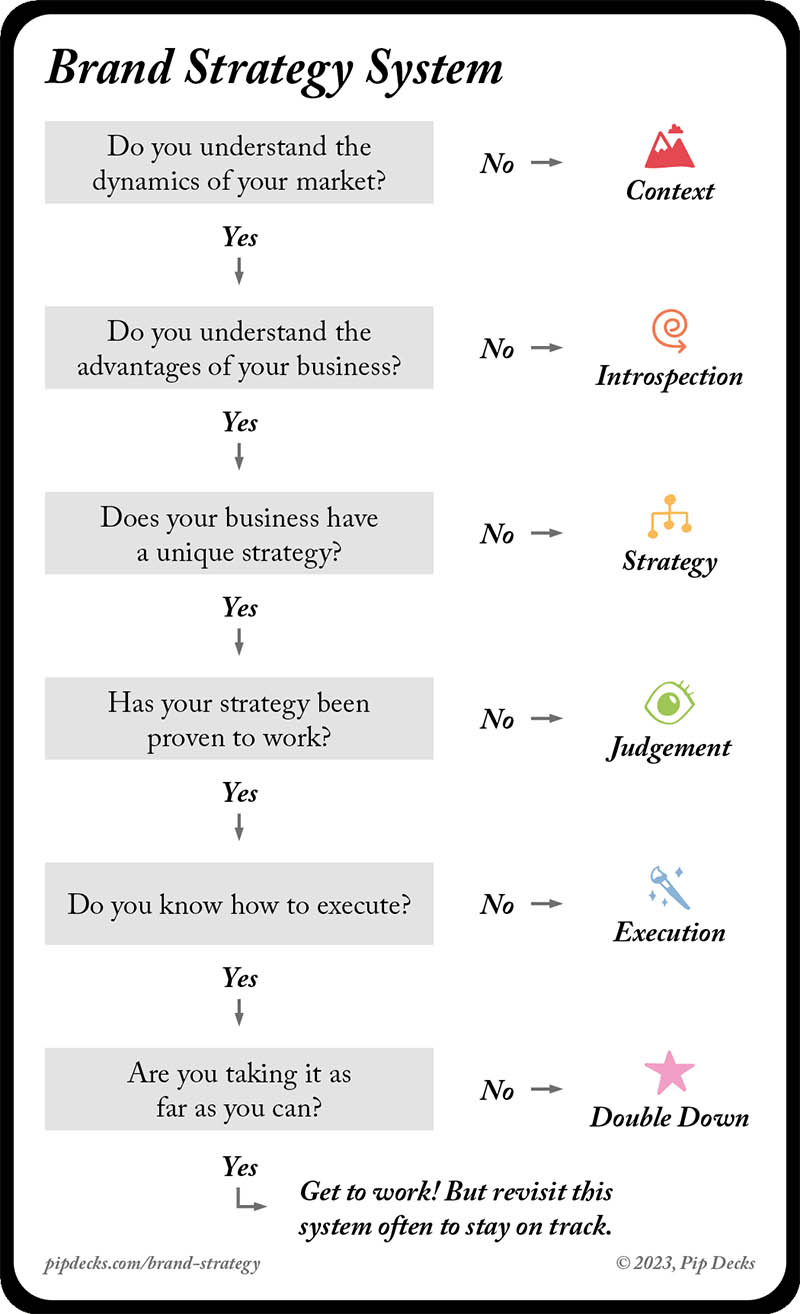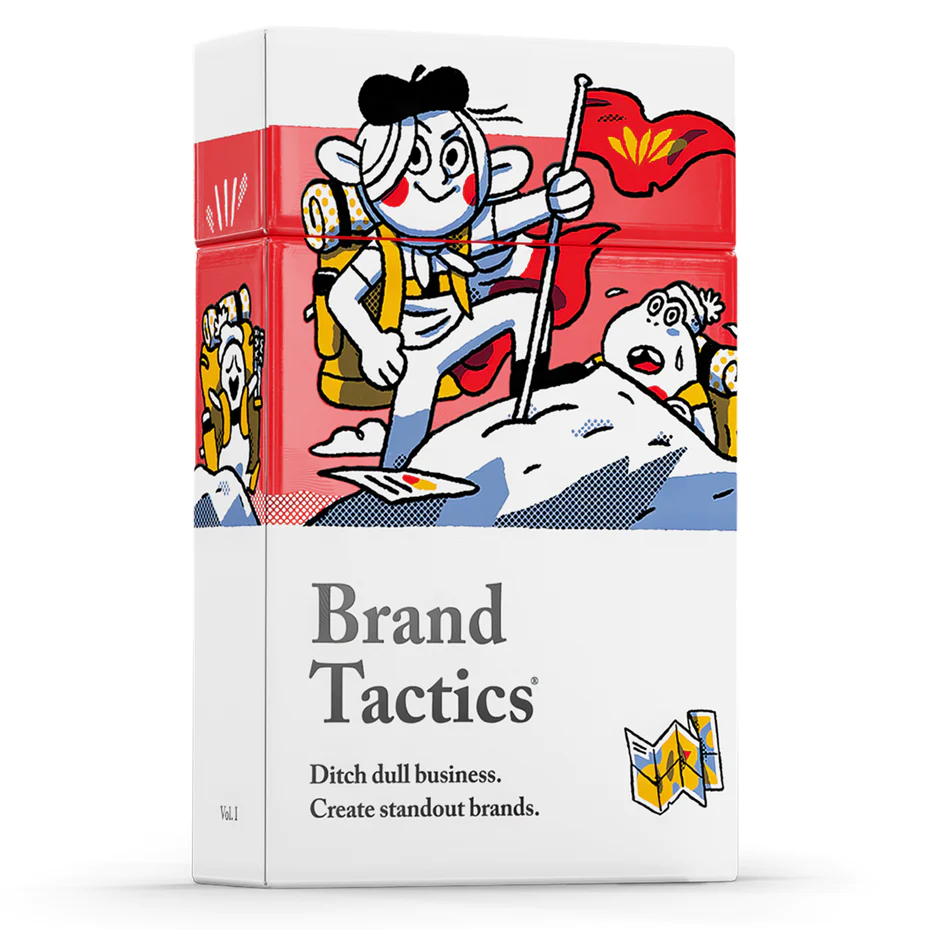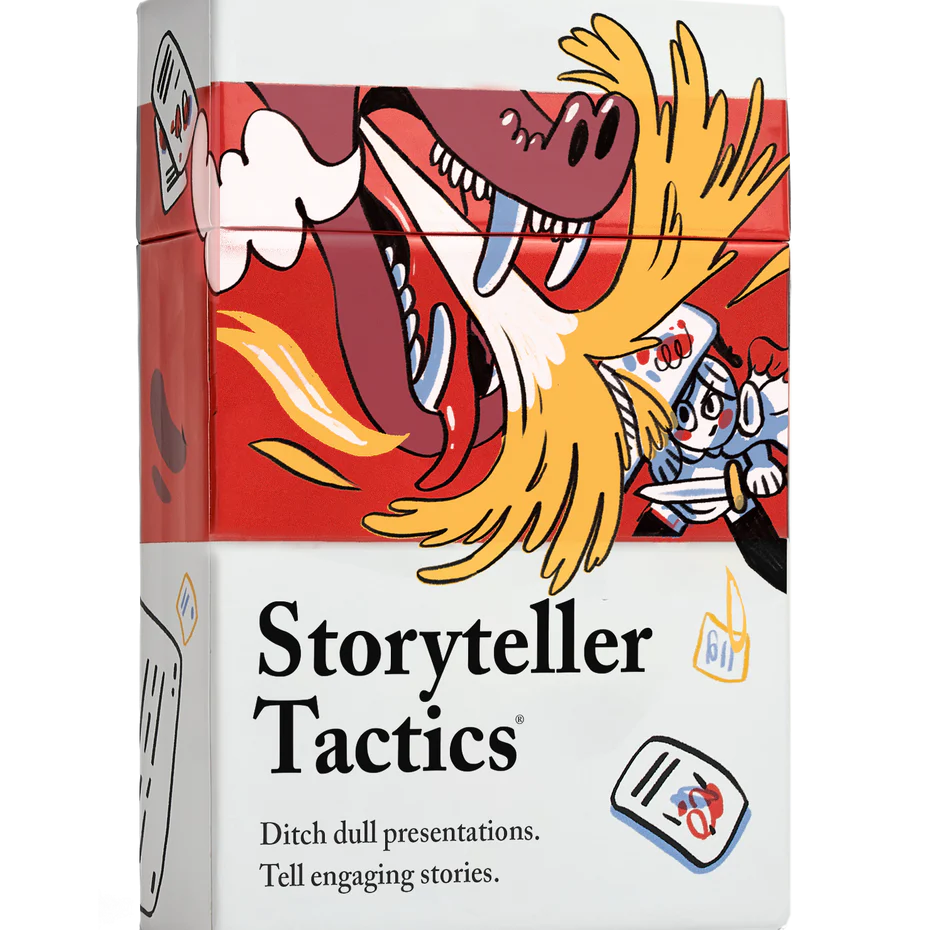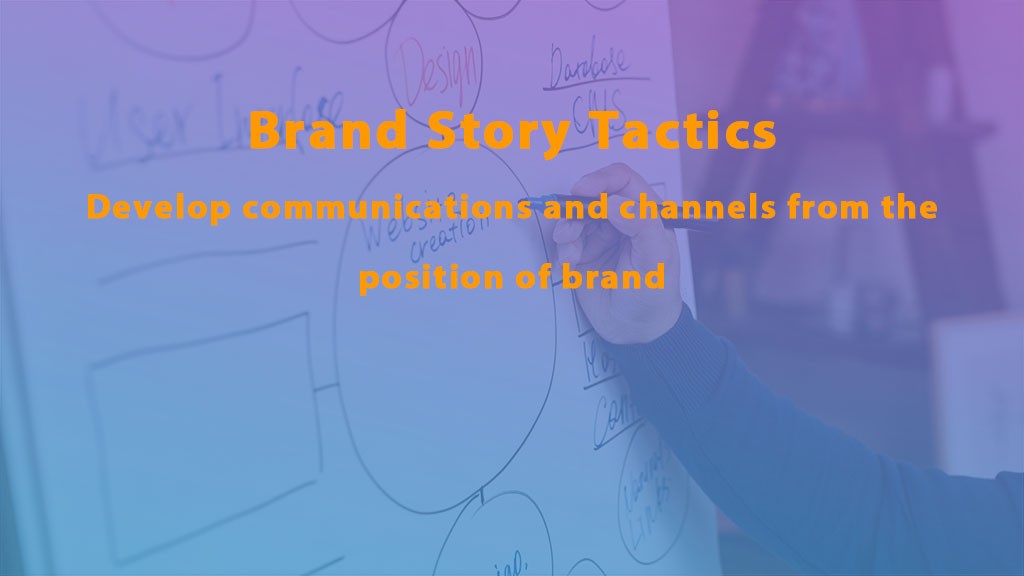Brand Tactics and Storyteller Tactics Pip Decks, An introduction
This article is derived from the video transcript discussing the Brand Tactics and Storyteller Tactics decks produced by Pip Decks:
Good morning, my name is Alan Murdock. This is the first time I’m going live, using a new live-streaming video tool, Riverside, so please forgive me if I ramble a bit. Today I’m going to talk about Storyteller Tactics and Brand Tactics, a new deck that I got from Pip Decks. Let’s take a look.
Let’s start with brand tactics.
Alan Murdock (00:58.222)
You can go to murdockmediaproduction.com/brand-tactics-deck/ for more information and a 15% discount off your order. The problem that brand tactics, the brand tactics deck solves, is converting big-picture, long-term, high-level vision into actionable steps.
A lot of people divert from focusing on their big-picture strategy to sales tactics. How do we move product? How do we motivate people? How do we get discounting going on and ultimately, that can undermine the position of your brand. Sales tactics can commodity your brand.
So brand tactics takes an approach where the strategy and the application are aligned and you’re doing your strategy work to figure out what to do. So when you have that mindset, that’s kind of the core of all the Pip Decks tools is how do we take something that we want to attain and turn it into actual behaviors and action.
Brand Strategy System
Understanding the Brand Strategy System in Pip Decks
The brand strategy system for this deck helps you to identify where to focus on your brand. It’s not linear, though you can go from start to finish. For example, the “double down” cards seemingly come at the end, but in fact, as you double down you’ll often be leveraging introspection, judgement and so forth in the process of deepening and committing to a direction.
Let’s talk through these categories of work:
Context
We need to figure out the context. In branding the context is always about the relationship. Branding ultimately is relationship building and that’s a fundamental principle that you know I think isn’t as strongly presented in the deck as it could be. It’s kind of assumed that you know that already.
Context…. Do we really meet the needs of our target audience? So the context is all about, what is the relationship between the target audience and what we as an organization can provide.
Really thinking about what is the audience. What do they do? What helps them?
Introspection
Reflection and Introspection We have to start reflecting. That’s where the introspection cards come in. Once we have reflected, then we can start to say, okay, well, here’s where we think we’re gonna make a guess, an educated guess about where we could go with this.
Strategy
Then we’re going to start modeling and testing things and building that out.
Judgment
That’s a determination of which pathways make real sense for us and which ones do we want to choose to follow. So we have some decision making.
Execution and Double Down
Then we have to apply it and make it happen.
The Brand Tactics deck by Pip Decks provides 54 cards with recipes and processes to clarify the scope and goals of their brand, align messaging with audience beliefs, establish REAL differentiation, and discover new ways to imagine their brand’s position in the market. With 54 actionable recipe cards, your team will have the steps it needs to create and maintain a vital brand.
Want to get the Brand Tactics deck right away? Grab yours with a 15% discount by using our Affiliate Link.
Small Businesses can Use Branding Too
Small Business Brand Challenges small businesses are often reselling products that exist in the marketplace and they’re trying to differentiate themselves within selling these common goods. So how can they differentiate themselves ?
Every business, every small business most often is a founder who really knows their stuff and they’re really trying to work hard in a particular field. And they’re good at what they do.
They’ve got authenticity because they’re committed to it and they’re doing it and people are drawn to that. They’re like, you know, Tom knows his stuff. So if you ever need that thing, go to Tom, right? And But then the question becomes okay, well, how do you expand that? How do you know, you know, maybe Tom hires a few people and but he can’t give up the core of the brand because It’s not in them. It’s in him, you know, so he’s really living the brand

Authentic Brands (08:45.314)
That is what an authentic brand really feels like. So if you think you’re special, then you have to test it. And you have to be really honest about whether you are stuck or not. There’s another card category, cliches, that starts to really dig into what are the cliche kinds of things in this category. A lot of times, you know, if you can create what your uniqueness is and then test it against all of the others.
What is your difference?
(11:07.582)
Is it weird? Does it stand out in a strange way? Or does it stand out in a way that people really want?
Brand is outside of what either the company describes it as or the audience describes it as.
Differentiation through Ethnographic Research
And so that means separating out all of our messaging about the product to the fundamentals of what it really does. So who does it serve? Who is that real product for? And how do they use it? That suggests getting into.
ethnographic research, going and meeting with people, observing them in their everyday lives using what it is that we offer.
Marty Neumeyer Zag
This is the book, Zag by Martin Neumeyer. He said, when everybody zigs, you zag. They go, everybody’s running in this one direction and you say, oh, what about over here? Nobody’s thinking about over here and that’s where we’re gonna go. So this real product card helps walk through that kind of process. Allow the brand to live outside your organization: Paper Boss.
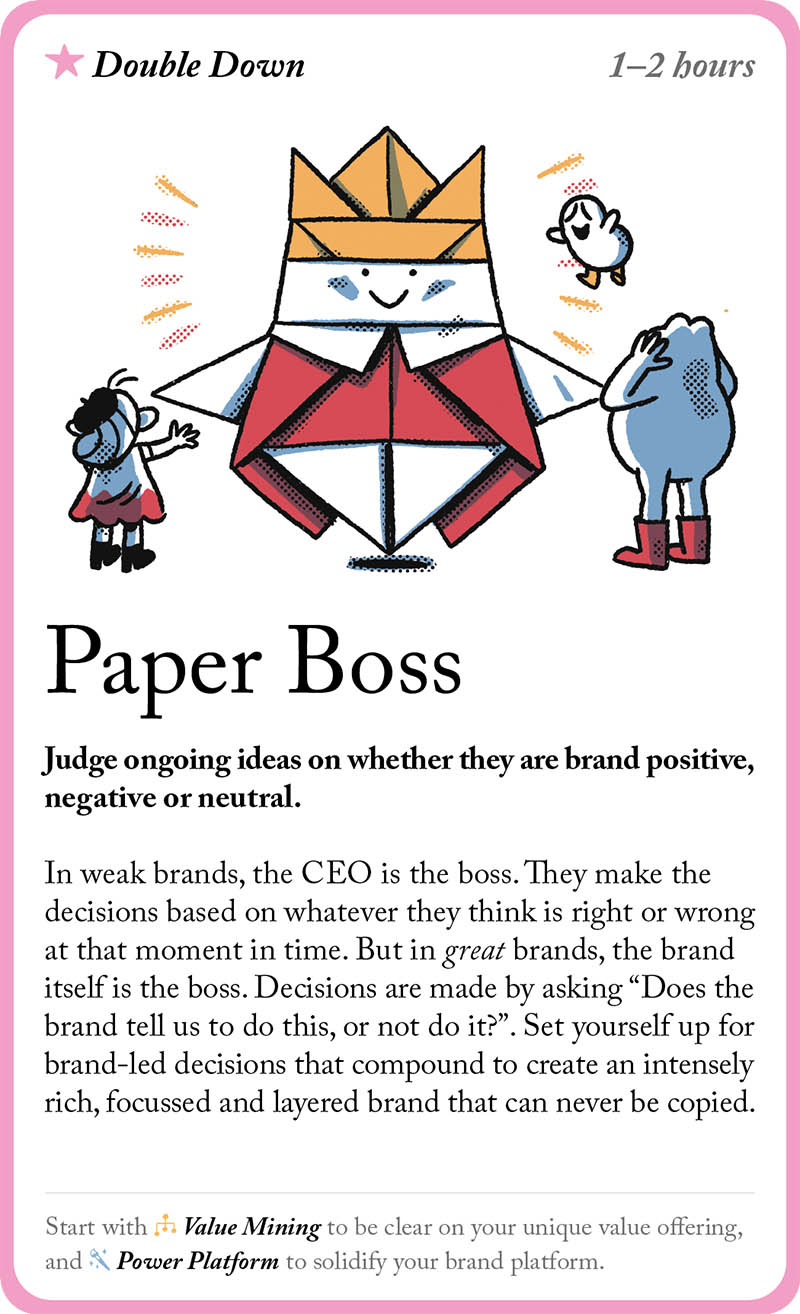
Paper Boss
So the Paper Boss is really what I was talking about earlier when we say, okay, the brand is outside of my control and it’s outside of the control of the audience. Everybody’s actually putting something into this and it’s separate from us. It’s an identity that’s separate from us.
Boss as Facilitator
and shaping that. Say, you know, when we founded this, these are the things that we were really working on. I see where you’re going with that. And these features of what you’re talking about makes sense, you know, let’s explore those. We’re gonna create an innovation group and we’re gonna figure that stuff out. And these things make sense right now. Let’s go charge ahead on those. And so the boss then becomes a facilitator of the team understanding the brand.
Pip Decks added tools
And you actually have multiple choices when you make a purchase. You can get a physical deck. So you got the physical deck and it is a physical set of cards.
You have a digital download, which includes the content of all of the cards in PDF form.
And then you also have access to something called the Vault.
So if you get the full package, you get the Vault. And the Vault has Miro boards with pathways and processes and training from person or people that wrote the deck.

Storyteller Tactics (23:41.626)
If I show Storyteller Tactics, the Miro board takes the card and it breaks out into the steps we’re going to do with that card, and it makes it interactive so each participant can add notes and make comments on the board.
In this example, there’s a video introduction and it goes through the topics on the card. So, okay, well, we’ve got stories to convince, three is the magic number, that’s funny, data detectives, and trust me, I’m an expert.
So if I pick one of these, that’s funny. How am I gonna work through that? So I’m gonna say, okay, in my story, what are the features that are fun, laughable components? What made other people laugh? And can I can add shape to the answer to that question.
And then there’s funny peculiar, that’s kind of interesting. So there’s a conflict, there’s something coincidental, there’s something that could shift in the way that I see things because of this kind of peculiarity. And then there’s acting funny, like who’s, what’s goofy here, what’s interesting, what caught my attention? And then as you work through this, so your team would basically create digital post-it notes and add those stickies to the designated area on the board, and you can watch the author walk through the instructional video if you get stuck.
So this is a great structure for working collaboratively.
Storyteller Tactics cards
So let’s talk about a few of these cards. And what I’ll do is I’ll open it up in my PDF.
Steve Rawling is the author of the Storyteller Tactics deck. Steve is a journalist who wrote for the BBC.
Brand storytelling is a really important part of brand strategy and that’s the reason that I wanted to talk about these two together because the brand story and the brand tactics really fit in terms of a process that people can develop together.
Storyteller Tactics Structure Alan Murdock (26:53.382)
A lot of times when people start with storytelling or writing, let’s say screenwriting, you start with the three-act structure, which is the way that plays have been written. You have a beginning that sets the tone, you have an inciting incident that pushes the characters into some new knowledge or some conflict and they have to make a choice in how they want to engage or respond to that conflict, and then they go on their journey.
Understanding your audience in Storyteller Tactics
Again, we’re talking about understanding the audience first. Where do we get information about our audience? And how do we know who we’re speaking to?
A simple sales story. What is it we do? Who do we serve? How we serve them? You, the prospect, might be like them, the satisfied customer.
The Storyteller Tactics deck is a set of 54 storytelling cards that are broken down into manageable story elements.
The deck is built to influence, educate, build awareness, lead - to basically attain all the big objectives businesses struggle with on a day to day basis - through powerful, well-placed stories.
Storyteller Tactics:
- a “storytelling system” to help identify what elements to develop based on where you are at in the story development journey
- “recipes,” which focus on your story objective (sell, motivate, inspire, explain, and so forth);
- “concepts” which are framing conventions - are you on a heroic journey, are you trying to solve a puzzle or mystery, or are you trying to balance order and chaos to make difficult things more manageable, or boring things more exciting?
- “exploration,” which is about getting the information you need to tell your story, whether through interviews, working together, or by some other means
- “character” cards that focus on roles - are you an expert? Is your customer the hero and you the guide?
- “function” cards that help you position your story in relation to what you are doing - pitching, selling, hunting for business insights and the like.
“structure” which digs into story arc options - “style” has to do with how you tell your story - what you put forward and what you hold back.
- and last, but not least, “organize.” A set of cards focused on how to collect and utilize stories over time.
Pip Decks Slack
Slack, so I’ll show that. If you go to pipdecks.slack.com, you can create a free account. That’ll allow you to see the last six months of conversations that are going on here. You can choose a paid account. And there’s a thread that you can follow for each deck. So Storyteller Tactics, people are in here asking questions and people are getting answers and the author is in here a lot.
You can interact with him and he really adds to people’s experience of working with the deck.

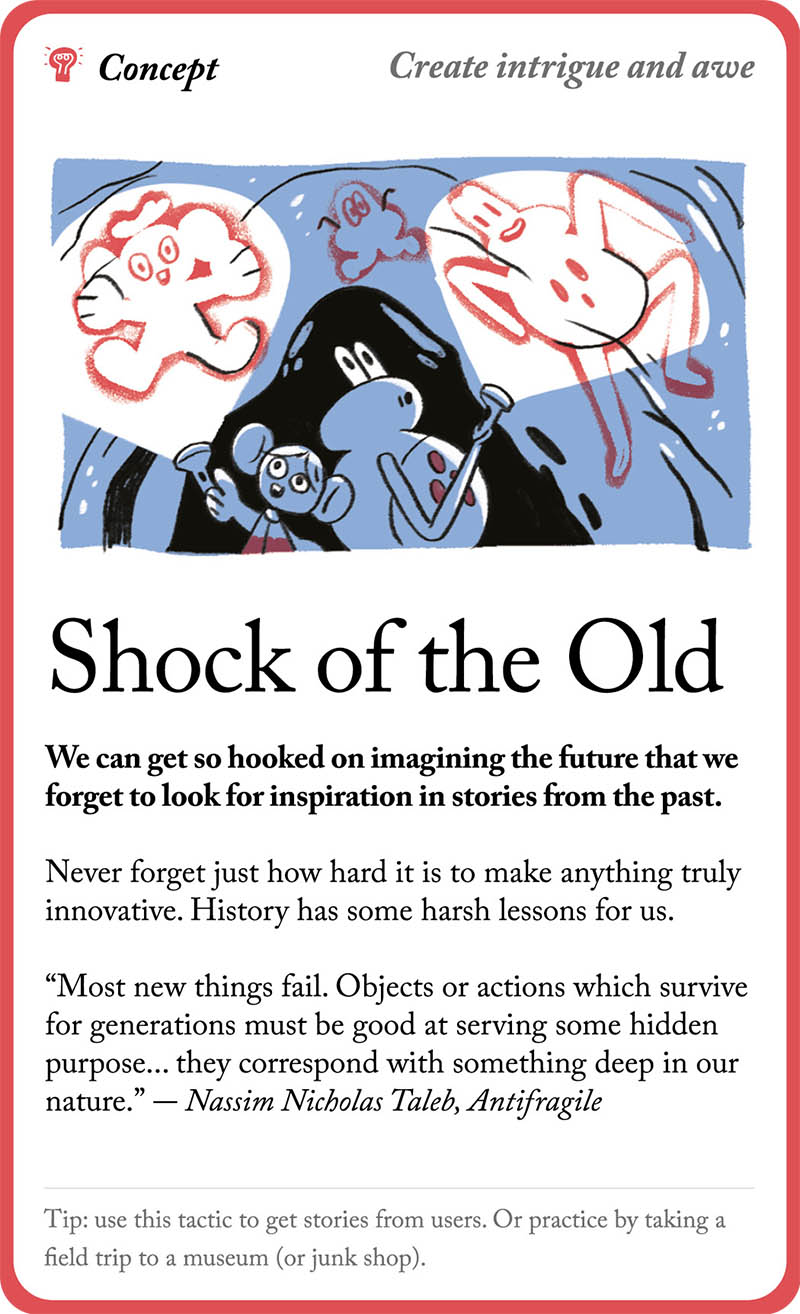
Dragon and the City
I’m gonna start with Dragon and the City. So Dragon in the City is kind of your Lord of the Rings story. You’ve got a threat that emerges to create risk for some ordinary world you care about and want to protect. There’s a normal way things are in your “city.” What is that city? What is your community like?
In your city, your community could be your business. It could be your customer’s lifestyle.
Shock of the Old
Shock of the Old is an interesting one. So in the place where I live, there’s an organization called Matthew 25 and they are a nonprofit organization. They’re working to empower people through urban farming, home repair, a lot of community-focused “resiliency” efforts.
The idea of shock of the old is a lot of times we say, “Okay, well, we should make an app to connect people.” Well, Pip Decks said, “Hey, we should make a deck of cards!” right? And people are using these cards because they get you off your phone a bit and you can actually take them out and hold them and they’re high quality printed and you aren’t burning any electricity while you’re looking at them. And so you’re going through the deck and turning the cards over, and it’s a physical thing.
People are talking about what’s on the card, using the processes. You’re going around in a group, and you’re getting away from everybody sitting and staring at a screen.
And so these decks of themselves, they combine the “shock of the old,” how good it is to get away from screens – they’ve got this hand quality of the deck itself and its physicality that has a “shock of the old” element to it. That’s combined with the digital quality of the video, the digital downloads, the Miro online collaborative tools, their blog and so forth.
Data Detectives Alan Murdock (38:26.806)
This is another great card, data detectives. So a lot of times in business, we’re expected to present hard information, but meetings packed with spreadsheets and metrics can be mind-numbing. The question can be, what is the insight that comes out of the data? How does the data become a story?
All stories begin with conflict
So one of the other things that I ask people when I’m talking about story development is, “Where is the conflict? What is the root of that conflict?” It’s actually ok for us to sometimes we can dig in and be skeptical about what’s being presented.
Pitch Perfect
The Pitch Perfect card is all about finding opportunities and plotting the path to actualize an outcome. The talking points for almost any business pitch include a Problem, the Opportunity, Practical Steps, and Future Promise.
It can be easy to figure out what the opportunity looks like. “Oh, we’ve got a problem. Here’s how we’re going to solve it.”
Somebody can do that as their whole job and try to present themselves as a hero because they figured out the opportunity, but that’s really only addressing the first half of a great pitch. It’s not actually enough. To deliver real value you actually have to take the steps to get there, and those steps are actually hard work. Some people just want to go “problem, opportunity, problem, opportunity,” staying focused on the first half of the card, then push everything else off to the operations department. They want to live in that world where there’s talking about problems and solutions. But
In some businesses there’s actually a divide between those who create ideas – that could be leadership, and those who actualize them. The second part is operations. So operations has to take the practical steps to get from the problem opportunity scenario.
But in many lean businesses and most small businesses, those who create ideas actually execute on them. Often they are executing for clients to whom they need to explain the relationship between the process and the outcome. Use Pitch Perfect as a way to show the path and get buy-in.
Want to learn more about brand storytelling?
Take my online brand building class, get the Storyteller Tactics deck, or begin with one-on-one coaching to shape your next project.
Take the Course!
The Branding Class for Artists, Small Businesses, and Anyone Who Wants to Make a Big Impact teaches the foundational framework of branding. Develop your brand platform, then connect it to your messaging. By the end of the course you’ll have actionable tools you will use each time you create content and messaging.
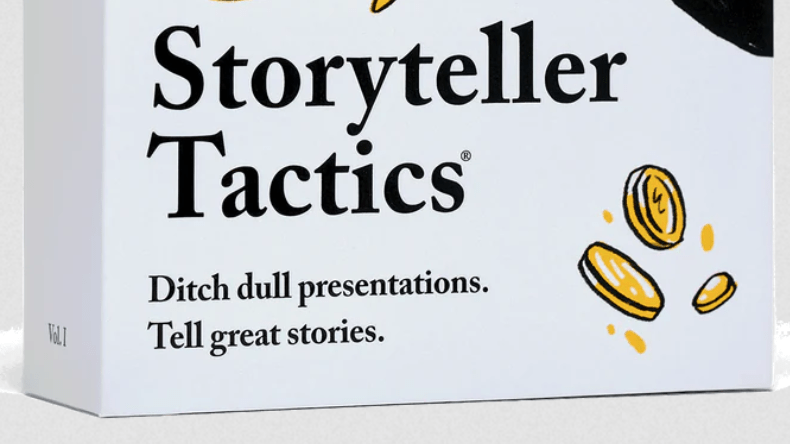
Get Storyteller Tactics
The Storyteller Tactics Deck includes 54 recipes that will immediately impact your storytelling. From pitch decks to ads, blogs, webinars, trainings, coaching, and more, these tools help you connect with your audience so they will remember, the “say, think and do” outcomes you are aiming for in your communications.
One-on-One Coaching
Stuck on the development of your communication pillars, key messages, or content? Let’s create a custom coaching plan to get you over the hump. The goal of coaching is to move you from doubt to clarity on your messages and communication tactics that help you build real resonance and relationships with your audience.

